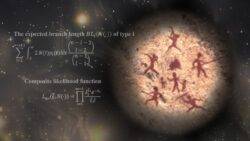The formula that helped solve a very old mystery (Picture: AAAS)
Humans’ ancestors almost went extinct around 900,000 years ago, suggests a new study.
Scientists say the early ancestral ‘severe bottleneck’, when the dwindling population was sustained by just 1,280 breeding individuals, could have spelled the end for modern humans as almost two-thirds of genetic diversity was lost.
However, it might have had an unexpected upside, leading to our intelligence as the brain evolved quicker due to natural selection.
The study, led by the University of Texas, used a new method of inferring ancient population size to shed light on a previously unexplained gap in the African/Eurasian fossil record.
Using the new method, called FitCoal – fast infinitesimal time coalescent process, the research team were able to accurately determine demographic inferences by using modern-day human genomic sequences from 3,154 individuals.
The findings, published in the journal Science, indicate that early human ancestors went through a ‘prolonged, severe bottleneck’ in which around 1,280 breeding individuals were able to sustain a population for about 117,000 years.
While the research has illuminated some aspects of early to middle Pleistocene ancestors, scientists say there are many more questions to be answered as a result of uncovering the information.
Several genomic sequences were analysed as part of the study.
Early humans were almost wiped out (Picture: Getty)
‘The fact that FitCoal can detect the ancient severe bottleneck with even a few sequences represents a breakthrough,’ said Senior author Dr Yun-Xin Fu, a theoretical population geneticist at University of Texas.
Dr Fu said the results found that early human ancestors experienced ‘extreme loss of life’, and therefore, loss of genetic diversity.
Study senior author Professor Giorgio Manzi, an anthropologist at Sapienza University of Rome, added: ‘The gap in the African and Eurasian fossil records can be explained by this bottleneck in the Early Stone Age.
‘It coincides with this proposed time period of significant loss of fossil evidence.’
The research team say that reasons suggested for the downturn in human ancestral population are mostly climatic as glaciation events around that time led to changes in temperatures, severe droughts, and loss of other species, potentially used as food sources.
For around 100,000 years, only a small number of individual kept the human race alive (Picture: Getty)
An estimated 65.85% of current genetic diversity may have been lost due to the ‘bottleneck’ in the early to middle Pleistocene era and the prolonged period of minimal numbers of breeding individuals threatened humanity as we know it today.
However, the researchers say that the bottleneck seems to have contributed to a ‘speciation event’, where two ancestral chromosomes may have converged to form what is currently known as chromosome 2 in modern humans.
They suggest, with that information, the last common ancestor has potentially been uncovered for the Denisovans, Neanderthals, and modern humans, or Homo sapiens.
Senior author Professor Yi-Hsuan Pan, of East China Normal University (ECNU), said: ‘The novel finding opens a new field in human evolution because it evokes many questions, such as the places where these individuals lived, how they overcame the catastrophic climate changes, and whether natural selection during the bottleneck has accelerated the evolution of human brain.’
The researchers said that now that there is reason to believe an ancestral struggle occurred between 930,000 and 813,000 years ago, they can continue digging to find answers to those questions and reveal how such a small population persisted.
They believe the control of fire, as well as the climate shifting to become hospitable for human life, could have contributed to a later rapid population increase around 813,000 years ago.
Senior author Professor LI Haipeng, a theoretical population geneticist and computational biologist at Shanghai Institute of Nutrition and Health, added: ‘These findings are just the start.
‘Future goals with this knowledge aim to paint a more complete picture of human evolution during this Early to Middle Pleistocene transition period, which will in turn continue to unravel the mystery that is early human ancestry and evolution.’
MORE : Our ancestors suddenly disappeared. Now we know why
MORE : Underworld discovery challenges our understanding of human evolution
At one point it was down to about 1,000 people to keep us all going.





